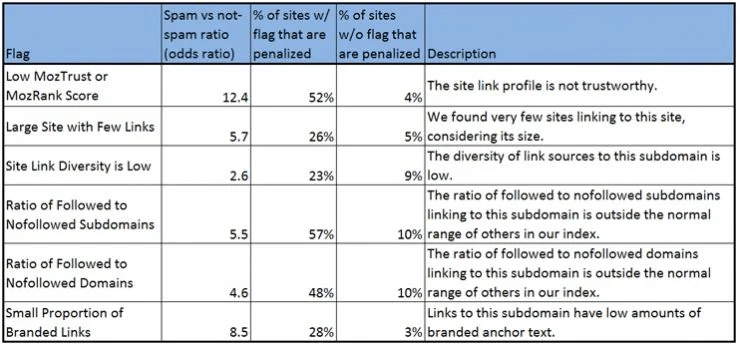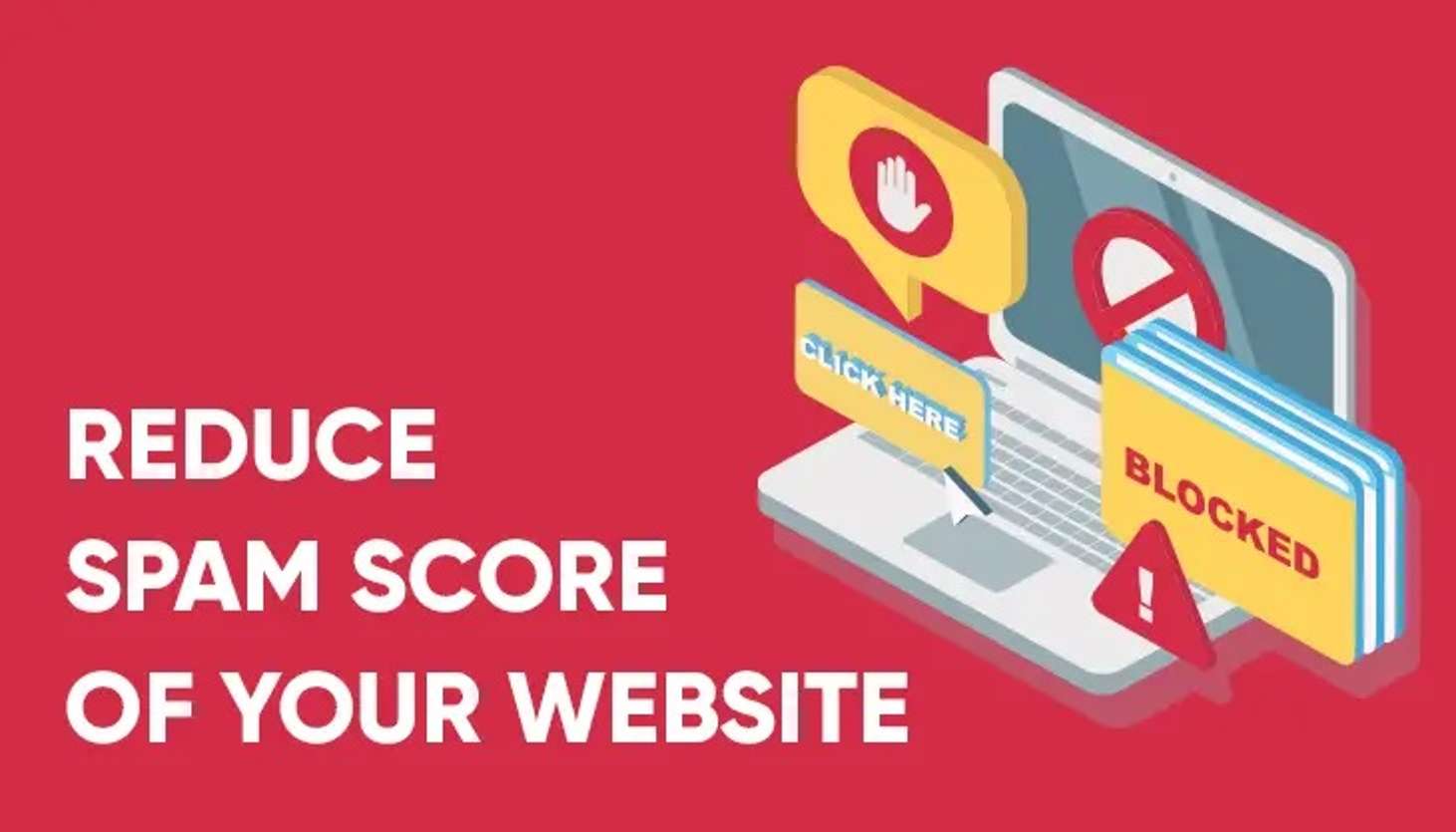Moz’s Domain Authority (DA) is a vital metric for understanding your website’s search engine visibility and authority. A high DA score can boost your SEO efforts, but a high spam score can hold you back
In this article, we’ll explore some quick wins that will show you how to lower your spam score and improve your website’s SEO performance.
Top Actions – How To Lower Your Spam Score.
- Create a text version.
- Avoid usage of spam sensitive words and phrases.
- Use normal text inside hyperlinks, instead of the URL.
- Use a proper from address.
- Use a proper subject line.
- Avoid HTML errors, unsupported techniques, obscure content, obfuscation.
- Images.
- HTML.
Spam Score Reduction Actions In Detail.
- Create a Text Version: Just as with email marketing, providing a plain text version of your content is crucial for SEO. This can help search engine crawlers understand your content better. In addition to your regular HTML content, consider providing a text-only version to improve accessibility and crawlability.
- Avoid Usage of Spam-Sensitive Words and Phrases: Moz’s spam score considers the content on your website. Avoid using spam-sensitive words and phrases that could trigger spam filters. This includes words like “free,” “guarantee,” or other aggressive marketing language. Focus on creating informative and valuable content instead.
- Use Normal Text Inside Hyperlinks, Instead of the URL: Search engines prefer clean and descriptive anchor text in hyperlinks. Instead of using raw URLs, use natural language in your anchor text. This practice not only helps reduce your spam score but also improves user experience and SEO.
- Use a Proper “From” Address: While this point is typically associated with email marketing, having a clear and recognizable “from” address for your website can also enhance your trustworthiness. Make sure your website’s contact information is easily accessible, indicating legitimacy to both users and search engines.
- Use a Proper Subject Line: Similarly, a clear and relevant subject line is important for SEO. Ensure that your page titles and meta descriptions accurately reflect the content of your webpages. Misleading titles can not only affect your spam score but also harm your search engine rankings.
- Avoid HTML Errors, Unsupported Techniques, Obscure Content, Obfuscation: Clean and error-free HTML code is essential for SEO. Use industry-standard coding practices and avoid obscure content or obfuscation techniques that can confuse search engine crawlers.
- Images: Optimise your images for SEO by using descriptive file names and alt text. High-quality images enhance user experience, and their proper optimisation can positively impact your Moz DA.
- HTML:Stick to clean and well-structured HTML for your website. Avoid excessive styling and formatting, which can make your website more user-friendly and search engine-friendly.
You can also follow these short steps:
- Continuous Backlink Monitoring: Regularly monitor your website’s backlinks by utilizing tools like Google Search Console or third-party SEO software. Take action by disavowing or removing low-quality or spammy backlinks.
- Craft Quality Content: Create and publish high-quality, original, and informative content that naturally attracts organic traffic and legitimate backlinks.
- Enhance Website Security: Bolster your website’s security by implementing SSL encryption (HTTPS) to safeguard data and ensure user privacy.
- Implement CAPTCHA Protection: Deploy CAPTCHA or other anti-bot measures to deter spammy form submissions and comments, preserving the integrity of user-generated content.
- Keep Software Updated: Maintain the currency of your website software, including content management systems (CMS) and plugins, to thwart potential vulnerabilities that could be exploited by spammers.
- Moderate User Contributions: Regularly oversee and moderate user-generated content, such as comments and forum posts, to prevent spammy submissions and maintain a positive user experience.
- Email Spam Filters: Employ email spam filters for addresses associated with your domain to minimize the influx of spam emails.
- User Account Audit: Conduct periodic audits of user accounts, and suspend or delete suspicious accounts that may be contributing to spammy activities.
- Report Spam: Report instances of spammy content or websites to relevant authorities and search engines to aid in the crackdown on malicious online activities.
- Professional Assistance: In cases where your spam score persists at a high level, consider seeking guidance from web security professionals or experts for further assistance and solutions.
Is Spam Score A Google Ranking Factor?
The Moz Spam Score Is Not a “Direct” Google Ranking Factor
Matthew Giannelis – CEO & Marketing Team Lead – Tech Business News
While the Moz Spam Score is a valuable indicator of potential issues with your website’s backlink profile, it’s important to clarify that it is not a direct Google ranking factor.
Let’s take a deep drive into the relationship between Moz’s Spam Score and Google’s ranking algorithm, and why the two are not the same.
1. Google’s Algorithm vs. Moz’s Spam Score:
Google’s search algorithm is a highly sophisticated system that considers numerous factors when determining search engine rankings.
These factors include the quality and relevance of content, user experience, on-page SEO, and the authority of backlinks, among others. Google’s algorithm is designed to provide users with the most relevant and valuable search results.
On the other hand, Moz’s Spam Score is a metric created by Moz to assess the potential “spamminess” of a website’s backlink profile.
It analyzes various aspects of backlinks, such as domain authority, link diversity, and the presence of spammy or low-quality links. Moz assigns a score between 0 and 100 to indicate the likelihood that a website’s backlinks may be spammy.
2. Google’s Approach to Bad Links:
Google is well aware of the importance of backlink quality in its ranking algorithm. However, Google does not rely on Moz’s Spam Score or any other third-party metric to make its decisions. Instead, Google uses its own algorithms and manual reviews to assess the quality of backlinks.
Google’s algorithms are designed to automatically detect and ignore bad or spammy links when determining search engine rankings.
The search engine giant has implemented various measures to ensure that manipulative or low-quality backlinks do not influence search results. This means that even if a website’s backlink profile has a high Moz Spam Score, Google will likely ignore those spammy links in its ranking considerations.
3. The Significance of Moz Spam Score:
While the Moz Spam Score may not directly impact Google’s ranking algorithm, it serves as a valuable indicator for website owners and SEO professionals.
A high Spam Score suggests potential issues in a website’s backlink profile, such as the presence of spammy links that could harm its online reputation.
How Is The SPAM Score Determined?
A website’s spam score is a metric derived from an extensive evaluation of your email’s content, along with certain checks related to Domain Name System (DNS) data.
The process involves a series of assessments based on predefined criteria. These criteria often utilise regular expressions to scrutinise both the body and header sections of the email message.
The spam scoring system is programmed to identify specific patterns or elements within your email. For instance, it can flag the presence of certain words or phrases like “Viagra” and “Casino” in the email’s content.
Additionally, it examines whether the sender’s address, referred to as the “from address,” actually corresponds to an existing and valid source.
In essence, the spam score serves as a mechanism to gauge the likelihood that an email may be considered spam by recipients or spam filters. It takes into account various factors, including the email’s content and its sender’s legitimacy.
Understanding how these elements contribute to your spam score is crucial in optimizing email deliverability and ensuring your messages reach the intended recipients’ inboxes rather than being relegated to spam folders.
Moz also says the spam score is based on its machine learning model which identified 27 common features among the millions of banned or penalised sites in the data we fed it.
A score of 1%-30% is considered a Low Spam Score. A score of 31%-60% is considered a Medium Spam Score. A score of 61%-100% is considered a High Spam Score.
Link Flags – Determined By MOZ
The table below displays various flags associated with links and anchor text, along with their respective odds ratios.
Each flag allows us to calculate two percentages: the percentage of websites featuring that flag that have been penalised by Google and the percentage of websites with the flag that have not faced penalties.

The odds ratio serves as a measure of the ratio between these percentages, indicating the heightened probability that a site is spam when it exhibits the flag.
For instance, in the initial row, it is stated that a website displaying this flag is 12.4 times more inclined to be classified as spam compared to one without the flag.
How To Avoid Spam Sensitive Words & Phrases
- Steer clear of terms such as Cialis, Levitra, soma, valium, Xanax, references to pricing per dosage, mentions of other pharmaceuticals by their chemical names, pharmacy-related language, Viagra, expedited delivery, and any attempts to obfuscate terms like Viagra and explicit content.
- It’s best to refrain from using words commonly exploited by spammers. Avoid disguising words or employing misspelled versions of prohibited terms.
- Don’t build hyperlinks that have the Uniform Resource Locator (URL) between the opening and closing tag, because some email clients interpret this as a phishing attempt.
For Example:
<a href="http://www.google.com">http://www.google.com</a>
<a href="http://www.google.com">www.google.com</a>Because the original link is replaced by your tracking domain the link will be blocked because email clients will find this discrepancy misleading to subscribers. Better do something like this:
<a href="http://www.google.com">Click here to visit a great search engine</a>
- This practice sometimes be misinterpreted by email clients and web browsers, potentially raising concerns or suspicions, particularly in the context of phishing attempts or suspicious web links.
- To maintain a clear and trouble-free user experience, opt for descriptive anchor text within the link, offering users a more informative and user-friendly navigation experience.
In some cases, malicious actors deliberately create or acquire low-quality, spammy backlinks pointing to a targeted website. This influx of harmful backlinks can trigger metrics tools to perceive a website as spammy, resulting in a higher spam score.
Removing or Disavowing Spammy Links
Website owners can use the Moz Spam Score as a diagnostic tool to identify and address potential problems in their backlink profiles.
While Google generally does an excellent job of recognising and ignoring bad links, it’s not infallible. There can be instances where a link that a spam score indicator might flag as bad is, in fact, a legitimate and beneficial link. If you hastily disavow such a link, you could unintentionally harm your website’s SEO by eliminating a valuable asset.
When Should You Use The Google Disavow Tool?
A. Anchor Text Over-Optimisation: If your backlink profile has been manipulated to the point of anchor text over-optimisation (i.e., too many exact-match anchor texts), and it’s adversely affecting your SEO, then using the Disavow Tool may be appropriate. This helps you regain control over your anchor text diversity.
B. Recovering from Penalties: In the unfortunate event that your website is hit with a manual or algorithmic penalty due to a problematic backlink profile, the Disavow Tool can be a crucial tool for recovery. By disavowing harmful links, you demonstrate your commitment to cleaning up your backlink profile.
Use the Disavow Tool judiciously, and only when you have genuine SEO concerns, such as anchor text over-optimization or the need to recover from penalties.
Summary Conclusion
It’s crucial to understand that the Moz Spam Score is not a direct Google ranking factor. Google’s ranking algorithm is a complex system that independently assesses the quality and relevance of websites and their backlink profiles. Google automatically ignores bad links and does not rely on third-party metrics like the Moz Spam Score.
The Moz Spam Score is a valuable tool for website owners and SEO professionals to evaluate the quality of their backlinks and address potential issues. However, it should not be used as your primary reference.
Avoiding a high spam score.
- Don’t use automated software. (Ever)
- Don’t intentionally build irrelevant links.
- Focus on building or acquiring quality links.
- Don’t spam blog comment sections or forums.
- Avoid content spinners and spammy anchor text.
By using the spam score as an indicator, website owners can take proactive steps to improve their backlink profiles, ultimately enhancing their website’s online reputation and SEO performance.
While not a direct factor, the Moz (DA) Spam Score remains a useful piece of the SEO puzzle. It’s also recommended to use several other measurement tools including Ahrefs, and Semrush to get a better overall image of your website performance in 2023.







